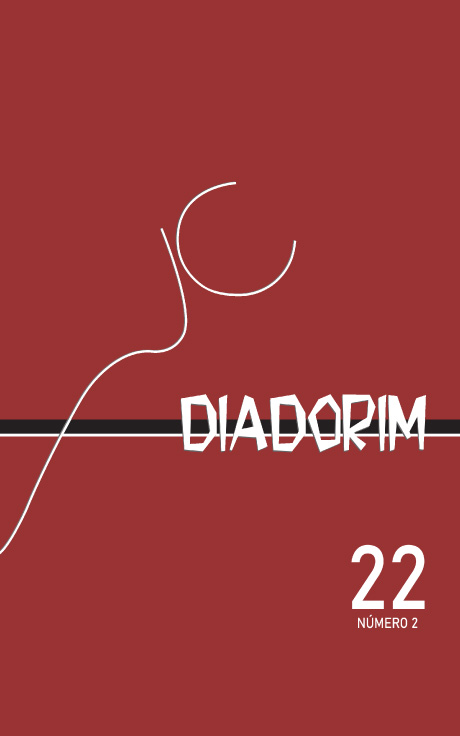O Sistema Responsivo do Português Brasileiro
DOI:
https://doi.org/10.35520/diadorim.2020.v22n2a32800Keywords:
fragmento de resposta, polaridade, negação, português brasileiroAbstract
Uma diferença marcante entre as línguas diz respeito à forma com que perguntas sim-não são respondidas: com partículas em francês, verbos-eco em irlandês e pela combinação de partículas e verbos-eco no Português. Essa distinção tem recentemente atraído a atenção da área da Teoria Gerativa. Holmberg (2013, 2016), por exemplo, afirma que a sintaxe das respostas a perguntas sim-não é em grande parte similar à sintaxe das perguntas. De acordo com o autor, a distinção tipológica entre sistemas baseados na verdade e sistemas baseados na polaridade está relacionada à posição que a negação ocupa; língua com um consistente sistema baseado em polaridade só apresentam negação média ou alta, enquanto línguas com um sistema baseado em verdade só apresentam negação baixa. Há ainda línguas como o inglês, que apresentam variação entre negação alta e baixa. O objetivo deste artigo é discutir qual o tipo de sistema responsivo do português brasileiro (PB), considerando que o PB apresenta três tipos de negação, dependendo do número e posição de itens negativos na sentença – Neg VP; Neg VP Neg e VP Neg.
Downloads
References
BIBERAUER, T.; CYRINO, S. Appearances are deceptive: Jespersen’s Cycle from the perspective of the Romania Nova and Romance-based Creoles, paper presented at Going Romance 23, University of Nice, Nice, 2009.
BORSLEY, R; JONES, R. Welsh negation and Grammatical Theory. Cartiff: University of Wales Press, 2005.
FARKAS, D.; BRUCE, K. On reacting to assertions and polar questions. Journal of Semantics v. 27, p. 81-118, 2010.
HOLMBERG, A. The syntax of yes and no. Oxford: Oxford University Press, 2016.
______. The syntax of answers to polar questions in English and Swedish. Lingua,v.128. Special Issue: Polarity emphasis: Distribution and locus of licensing, p. 31-50, 2013
JONES, B. M. The Welsh answering system. Moton de Gruyter, 1999.
KATO, M.A.; TARALLO, F. Sim: respondendo afirmativamente em português. . In PASCHOAL, M.S.Z.; CELANI, M.A.A. (eds). Linguística Aplicada: da Aplicação da Lingüística para uma Lingüística Transdisciplinar. São Paulo: EDUC, pp. 259.278, 1992.
KATO, M.A. Minimal answers and IP-remnanent movement. 2010 (apresentação oral)
KATO, M.A.; CYRINO, S. Minimal answers in Brazilian Portuguese. 2012 (apresentação oral)
KRAMER, R.; RAWLINS, K. An ellipsis approach to answer particles in positive and negative contexts, 2012.
KUNO, S. The structure of the Japanese language. Cambridge, MA: Massachusetts Institute of Tecnology,1973.
LAKA, I. On the syntax of Negation. New York: Garland, 1994.
MARTINS, A. M. Emphatic polarity in European Portuguese and beyond. Lingua, v.128, p. 95-123, 2013.
OLIVEIRA, M. Frases assertivas e suas variações nas línguas românicas: o seu papel na aquisição. São Paulo: Humanitas, 2000.
POPE, E. N. Questions and answers in English. The Hague/Paris: Mouton, 1976.
RIZZI, L. The fine structure of left periphery. InHaegeman, L. (ed). Elements of Grammar, p. 281-337, Kluwer Academic Puplishers, 1997.
TEIXEIRA DE SOUSA, L. Sintaxe e interpretação de negativas sentenciais no Português Brasileiro. Tese (DoutoradoemLinguística), Unicamp, 2012.
______. Three types of negation in Brazilian Portuguese.Lingua, v. 159, p. 27-46, 2015.
WALKER, M. Inferring acceptance and rejection in dialogue by default rules of inference. Language and Speech, v.32, n.2, p. 39-2, 1996.
Downloads
Published
Issue
Section
License
Copyright transfer -- Authorization to publication
If the submitted article is approved for publication, it is already agreed that the author authorizes UFRJ to reproduce it and publish it in Diadorim: revista de estudos linguísticos e literários, the terms "reproduction" and "publication" being understood as defined respectively by items VI and I of article 5 of Law 9610/98. The article can be accessed both by the World Wide Web (WWW) and by the printed version, with free consultation and reproduction of a copy of the article for the own use of those who consult. This authorization of publication is not limited in time, and UFRJ is responsible for maintaining the identification of the author of the article.

The journal Diadorim: revista de estudos linguísticos e literários is licensed under a Creative Commons Attribuition-NonCommercial 4.0 International (CC BY-NC 4.0).

